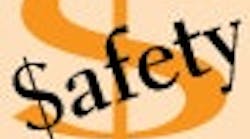Engineers are bombarded with mantras about “safety compliance” and “standards conformity.” If you are not following the latest safety decrees, you could jeopardize your company’s ability to do business, not to mention liabilities you could incur.
Fair enough, but no one wants to recognize the question of how much it is going to cost. I’m not referring to the costs of implementing these procedures. Rather it’s about the cost just to even learn the information in these standards.
This issue came up after I had replaced an old extrusion press controller system with a new PLC. Being a good engineer, I had the customer contact the local city engineering department. The inspector said that since this machine never stood a chance of being UL certified, it would need to be certified by an independent compliance company.
This was the first inspection for this machine, so I was quite proud when the authorized, independent, compliance engineer found few discrepancies, and most of them involved not having the proper safety signs affixed to the machine. The inspector’s report frequently referred to UL 508 and UL 508A as the authority for items that needed to be fixed.
Being a conscientious engineer, I asked the inspector if I could get more than just a reference number to this standard. He politely chuckled. He wasn’t trying to embarrass me, but he clearly was amused by my request. He said I would have to find and purchase these standards for myself.
I did a web search for these standards and quickly understood the inspector’s reaction. The least expensive price I was quoted for UL 508 and UL 508A was about $450 apiece, and other places wanted as much as $600 each.
UL 508 is “UL Safety Standard for Industrial Control Equipment,” and UL 508A is “UL Safety Standard for Industrial Control Panels.” UL 508 is in its 17th edition as of January 1999 and contains revisions through July 2005. UL 508A is a first edition, dated April 2001, and also includes revisions through July 2005. UL 508 contains 208 pages of actual information, and UL 508A is 160 pages.
I read both standards from cover to cover. When I finished, one thought kept going through my head: “Why am I paying so much for these documents?” There were about two dozen pages between both of these documents that actually pertained to my specific situation. I paid $900 to find the reference for not affixing the proper signage?
If you are an inspection or compliance company, you must have these documents and understand all of what’s in them. That’s the price you pay to be in that business.
Today’s engineering consumers are savvier, and paying for information they don’t need doesn’t make good business sense. If I pay $900 for a software program, I expect it to solve business or technical problems for a long time, not just be used once or twice and put on the shelf.
I have two issues with what happened to me and probably happened to other engineers trying to do the right thing. First, a significant portion of these standards don’t contain information relevant to a particular application. This has been going on for decades but never seems to get addressed. Second, standards companies still charge as if you were getting an actual book, but they are delivering PDF files. I had to tell my customer I paid $900 for two PDF files to find which paragraph referenced the required signage.
It’s fair for a company to recoup its research costs, but hasn’t UL been able to amortize their initial costs for a safety standards book by the time the 17th edition appears? Spare me the “continuing research” argument. The physics of electrical panel safety does not change that often.
Many publishers sell e-books at a fraction of the cost of the hard copy. Why can’t this business model be adopted by the standards companies?
Why can’t standards companies also provide more application-focused material? Is it that hard to extract the standards requirements for retrofitting a machine?
If all engineered applications should achieve a recognized level of safety, then there must be a less expensive way for the engineering consumer to have access to specific, relevant information.
Weight in on this article by participating in our discussion on MBF, click here to post comments.
SCOTT GEE, chief software architect at ISDTech, Canyon Country, Calif., has more than 30 years of experience in engineering and software development. Learn more at isdtech.com.




